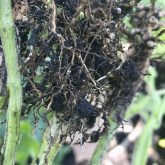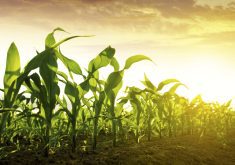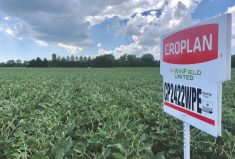In the next 10 to 30 years, could corn and soybeans became lesser crops in Ontario and Eastern Canada? What would that look like and how might that unfold?
Before you say, “It’ll never happen,” think back to 1992 and changes such as transgenics, GPS and precision ag technologies and production capabilities that have virtually doubled yields in most crops. That sets the stage for a followup question: With these conditions, why change?
It may not be a matter of “wanting” to change as having it imposed by developments and trends here and in other countries. Concerns over climate change and the environment are driving interest in electric vehicles, which has already affected the U.S. ethanol industry. Recovery from the COVID-19 pandemic and now the war in Ukraine are behind a push for greater self-sufficiency, possibly necessitating a more diverse food-based production system.
Read Also

Could crop sharing be a viable option for your farm?
Crop sharing could be a good option for young and beginning farmers.
Lots of time
How the next 10 to 30 years will unfold for corn and soybean production is anyone’s guess, but it’s been a recent topic of discussion for Emery Huszka and Stephen Denys. The two have tossed the idea around and although both concede there’s a lot of uncertainty, now’s a good time to start the conversation.
“In reality, we’re already somewhat transitioned with corn and soybeans,” says Huszka, a grower who farms near Florence, and is also a District 3 director for the Grain Farmers of Ontario (GFO). “Twenty-five to 30 years ago, when we were talking ethanol for the first time, it was a different marketplace. When we achieved the ethanol mandate, it was a saviour to us as corn farmers and gave us a solid market. It added to the country’s ability to put off some of our usage of fossil fuels and gave us time and space to think this through.”
Huszka says farmers are eminently practical. They see challenges, draw on community knowledge, look through a scientific lens, seek the appropriate advice, and then move toward a vision of their work, making changes as needed for the short, medium and long term. He doesn’t see a future where there is a wholesale shift away from growing corn or soybeans, pointing to research by the GFO into new uses and markets for all Ontario grains.

When he looks at the genetics during the past 30 years, Huszka sees a tremendous impact on performance and yields. Production has moved to more marginal soils, with crops boasting higher test weights or higher oil content.
“We’re fine-tuning our craft,” he says. “But will farmers take advantage of new markets? You bet. Will we watch the trends in the world and ensure our fields are providing what’s needed? We always do.”
While corn and soybeans form a strong foundation for Ontario’s cropping plans, Huszka says they make up only about half of the provincial picture, and there are strong complementary crop options. The other perspective on the situation is that nothing will happen overnight.
“I watch our neighbours to the south as others do, just to see what they’re doing and how they’re doing it,” says Huszka. “But let’s face it, the oil industry is a trillion-dollar industry in the U.S. and it isn’t going to just roll over. If they’re going to continue, that means biofuels are a walking partner, so I don’t see it disappearing in the States. As the people who grow our food, we know there are very few simple answers to any situation.”
Delicate balance
Benjamin Schapelhouman, a certified crop advisor based in Temiskaming District, has a unique vantage point on potential changes to cropping mix. He notes that 15 years ago, there was talk of climate change shifting more corn and soybean production in Western Canada. Yet soybean is the only crop that’s seen higher acreage in Manitoba and Saskatchewan, and it’s still low relative to canola and cereals.
Schapelhouman notes the Prairie producers have less flexibility for growing more canola, which would come at the expense of crops like flax, peas or lentils. The challenge there is the balance of growing a year of canola, a pulse and two years of cereals. Shorter canola rotations are problematic because of insect pressures and diseases such as clubroot.
“I could see that happening but then something has to give,” says Schapelhouman. “If you’re growing more soybeans, then something similar is going to have to leave the rotation.”
In Ontario’s “Near North,” there’s room for more soybeans, with growers willing to shift their acres accordingly. But unless producers are growing corn — possibly under plastic — and feeding it to their cattle, it’s just not a crop that’s suited to the cooler, shorter season and distance to feed or processing markets.
“Even if the climate warms in the next 10 years, all other things being equal, I don’t see the corn situation changing here,” says Schapelhouman.
Like Huszka, Schapelhouman doesn’t believe there’ll be a sudden shift away from the two staples: growers will have plenty of advance notice. In spite of talk of land development in Canada, Brazil, Ukraine and Central Africa, the world is balanced and positioned to use most of what it grows. Expansion will come when demand for grains and oilseeds is more urgent.
“My understanding is it’s difficult for the Chinese and Indians to bring new land into production because they’re los- ing it to urbanization,” says Schapelhouman. “It’ll probably be the Chinese who stand to gain the most from bringing Central Africa into production or increasing their own production.”
The biggest problem facing anyone turning undeveloped land into farmland is dealing with the environmental push-back and political issues in any of those countries.
“What we can do is if the market wants — and pays for — more edible oils, we can produce quite a bit more — at the expense of something else, like cereals and forages,” says Schapelhouman. “We’ll just produce more canola and more soybeans if we get into Manitoba and Northern Ontario, because we can.”
Just brainstorming
Stephen Denys echoes the notion that little is about to change in the short term, but he’s had more of these conversations with other farmers who are trying to identify longer-term outlooks, especially for corn and soybeans.
“One thing that sometimes limits the exploration or adoption of other options is the fact there has been a great deal of investment in corn and soybeans over time,” says Denys, director of market and product development with Maizex Seeds.
“They’ve made these crops easier to produce in mass-production systems, in particular with herbicide and insecticide tolerance. When it comes to a discussion on economics, in many cases, these crops become hard to turn away from as a result.”
Thirty years ago, he adds, it might have been easier to consider other options, before transgenic GMOs and GPS technology.
If there’s a crop in waiting that could shift acres away from corn or soybeans in Ontario, Denys believes it’s winter canola. The equipment’s in place, processors are happy to accept it and there are farmers with multi-year success with it. It fits well after winter wheat, it spreads the workload and offers attractive prices, while utilizing different classes of chemistry — since winter canola is non-GMO — compared to what corn and soybeans require.
“Other options are more regionally specific,” says Denys, citing hybrid rye as a crop with strong potential, not only for industrial uses like alcohol but as a feed source for hogs. “This could be a tremendous cereal option with higher yield potential on lighter soils than open-pollinated varieties.”
Edible beans, sugar beets and increased vegetable production — at least in the extreme southwestern corner of the province — could decrease corn or soybeans acreage while enhancing on-farm practices for some farmers.
“We’re actually in a good position in Eastern Canada as the elevator industry already segments crops, including IP soybeans,” says Denys. “Adding crops is easier to do in my mind versus the U.S. Midwest where segmentation would be more difficult.”
– This article was originally published in the September 2022 issue of the Corn Guide.
















